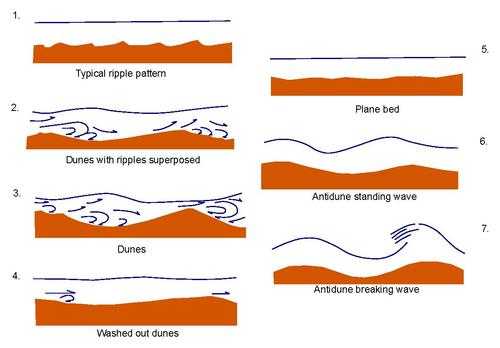Bedform

A bedform is a feature that develops at the interface of fluid and a moveable bed, the result of bed material being moved by fluid flow. Examples include ripples and dunes on the bed of a river. Bedforms are often preserved in the rock record as a result of being present in a depositional setting. Bedforms are often characteristic to the flow parameters,[1] and may be used to infer flow depth and velocity, and therefore the Froude number.
Bedforms vs. flow
Typical unidirectional bedforms represent a specific flow velocity, assuming typical sediments (sands and silts) and water depths, and a chart such as below can be used for interpreting depositional environments,[2] with increasing water velocity going down the chart.
| Flow Regime | Bedform | Preservation Potential | Identification Tips |
| Lower | |||
| Lower plane bed | High | Flat laminae, almost lack of current | |
| Ripple marks | High | Small, cm-scale undulations | |
| Sand waves | Medium to low | Rare, longer wavelength than ripples | |
| Dunes/Megaripples | High | Large, meter-scale ripples | |
| Upper | |||
| Upper plane bed | High | Flat laminae, +/- aligned grains (parting lineations) | |
| Antidunes | Low | Water in phase with bedform, low angle, subtle laminae | |
| Pool and chute | Very low | Mostly erosional features | |
This chart is for general use, because changes in grain size and flow depth can change the bedform present and skip bedforms in certain scenarios. Bidirectional environments (e.g. tidal flats) produce similar bedforms, but the reworking the sediments and opposite directions of flow complicates the structures.
This bed form sequence can also be illustrated diagrammatically:

Types of Bedforms
Lower Plane Bed
"Lower plane bed" refers to the flat configuration the bed of a river that is produced in via low rates of sediment transport.[3]
Upper Plane Bed
"Upper plane bed" features are flat and characterized by a unidirectional flow with high rates of sediment transport as both bed load and suspended load. Upper plane bed conditions can produce parting current lineations, which are typically subtle streaks on the bed surface due to the high energy flow.[3]
See also
References
- ↑ Southard, J B (1991). "Experimental Determination of Bed-Form Stability". Annual Review of Earth and Planetary Sciences 19: 423. Bibcode:1991AREPS..19..423S. doi:10.1146/annurev.ea.19.050191.002231.
- ↑ Prothero, D. R. and Schwab, F., 1996, Sedimentary Geology, pg. 45-49, ISBN 0-7167-2726-9
- ↑ 3.0 3.1 editors, Klaus K.E. Neuendorf, James P. Mehl, Jr., Julia A. Jackson. (2005). Glossary of geology. Alexandria: American Geological Institute. p. 382. ISBN 0-922152-76-4.
| ||||||||||||||||||||||||||||||